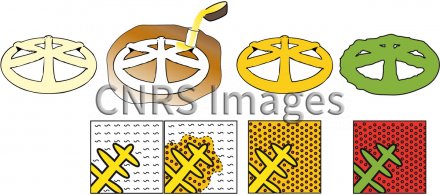Production year
2016

© L. BERTRAND / T. SEVERIN-FABIANI / S. SCHOEDER / IPANEMA CNRS MCC UVSQ / Synchrotron SOLEIL / CNRS Images
20160106_0005
Reconstitution of the stages of the metallurgical process used to produce the Mehrgarh amulet, a copper object from the ancient Chalcolithic period found in the 1980s in present-day Pakistan. The secret of its manufacture has been revealed thanks to a new approach using UV/visible photoluminescence spectral imaging. A model was formed in a ductile material with a low melting point such as beeswax. Different wax coils were melted to each other by lightly heating their ends. The wax model was then encased in clay to form a mould. The mould was first heated to run off the melted wax, then fired at a high temperature. Molten copper was then poured into the mould to fill space previously occupied by the wax model. After cooling the mould was broken to remove the copper object. Abandoned on the ground, the copper slowly corroded completely, forming hydroxychlorures in the dendrites (green) and cuprous oxide in the interdendritic area (red).
The use of media visible on the CNRS Images Platform can be granted on request. Any reproduction or representation is forbidden without prior authorization from CNRS Images (except for resources under Creative Commons license).
No modification of an image may be made without the prior consent of CNRS Images.
No use of an image for advertising purposes or distribution to a third party may be made without the prior agreement of CNRS Images.
For more information, please consult our general conditions
2016
Our work is guided by the way scientists question the world around them and we translate their research into images to help people to understand the world better and to awaken their curiosity and wonderment.